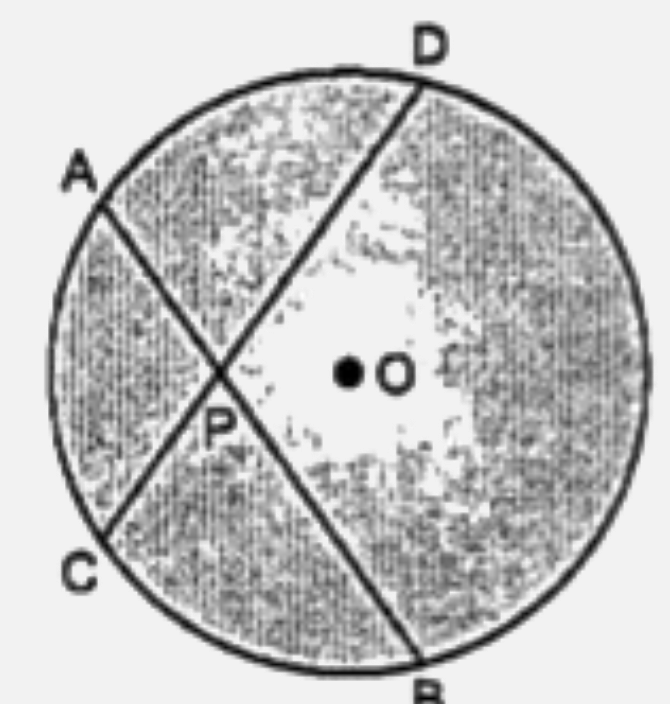Let S=Set of points inside the square, T=set of points inside the triangle and C=the set of points inside the circle. If the triangle and circle intersect each other and are contained in a square. Then (i) S∩T∩C=ϕ (ii) S∪T∪C=C (iii) S∪T∪C=S (iv) S∪T=S∩C
S∩T∩C=ϕ
S∪T∪C=C
S∪T∪C=S
S∪T=S∩C
The correct Answer is:C
To solve the problem, we need to analyze the relationships between the sets S, T, and C based on the given conditions. Let's go through the options step by step.
Step 1: Understand the Sets
- S: Set of points inside the square.
- T: Set of points inside the triangle.
- C: Set of points inside the circle.
Step 2: Analyze the Given Conditions
- The triangle T and the circle C intersect each other.
- Both T and C are contained within the square S.
Step 3: Evaluate Each Option
Option (i): S∩T∩C=ϕ
- This option states that the intersection of all three sets is empty.
- Since the triangle and circle intersect, there are points that belong to both T and C. Hence, S∩T∩C cannot be empty.
- Conclusion: This option is false.
Option (ii): S∪T∪C=C
- This option states that the union of all three sets is equal to the set of points inside the circle.
- Since both the triangle and the square contain points that are not in the circle, this option cannot be true.
- Conclusion: This option is false.
Option (iii): S∪T∪C=S
- This option states that the union of all three sets is equal to the set of points inside the square.
- Since both the triangle T and the circle C are contained within the square S, this is indeed true.
- Conclusion: This option is true.
Option (iv): S∪T=S∩C
- This option states that the union of the square and triangle is equal to the intersection of the square and circle.
- Since the triangle is part of the square, S∪T will include all points in S and some points in T, while S∩C will only include points that are in both S and C. Hence, this statement is not true.
- Conclusion: This option is false.
Final Conclusion
The only correct option is (iii): S∪T∪C=S.
- S: Set of points inside the square.
- T: Set of points inside the triangle.
- C: Set of points inside the circle.
- The triangle T and the circle C intersect each other.
- Both T and C are contained within the square S.
- This option states that the intersection of all three sets is empty.
- Since the triangle and circle intersect, there are points that belong to both T and C. Hence, S∩T∩C cannot be empty.
- Conclusion: This option is false.
- This option states that the union of all three sets is equal to the set of points inside the circle.
- Since both the triangle and the square contain points that are not in the circle, this option cannot be true.
- Conclusion: This option is false.
- This option states that the union of all three sets is equal to the set of points inside the square.
- Since both the triangle T and the circle C are contained within the square S, this is indeed true.
- Conclusion: This option is true.
- This option states that the union of the square and triangle is equal to the intersection of the square and circle.
- Since the triangle is part of the square, S∪T will include all points in S and some points in T, while S∩C will only include points that are in both S and C. Hence, this statement is not true.
- Conclusion: This option is false.
The only correct option is (iii): S∪T∪C=S.
Topper's Solved these Questions
- SETSBook:ICSEChapter:SETSExercise:EXERCISE 1 (a)
Explore 57 Videos
- SETSBook:ICSEChapter:SETSExercise:EXERCISE 1 (b)
Explore 28 Videos
- SETSBook:ICSEChapter:SETSExercise:CHAPTER TEST
Explore 46 Videos
- SEQUENCES AND SERIESBook:ICSEChapter:SEQUENCES AND SERIESExercise:MULTIPLE CHOICE QUESTIONS
Explore 34 Videos
- STATISTICSBook:ICSEChapter:STATISTICSExercise:CHAPTER TEST
Explore 4 Videos
Similar Questions
Let S= set of point inside the sqare, T= set of points inside the triangles and C= the set of point inside the circle, if the triangle and circle intersect each other are contained in the square, then (a) S∩T∩C=ϕ(b)S∪T∪C=C(c) S∪T∪C=S(d)S∪T=S∩C
View SolutionUse ruler and compasses only for this question
Construct the locus of points inside the triangle which are equidistant from B and C.
View SolutionThe area of an equilateral triangle is 49√3cm2 . Taking each angular point as shown in Figure. Find the area of the triangle not included in the circle.
View SolutionThe area of an equilateral triangle is 49√3cm2 . Taking each angular point as shown in Figure. Find the area of the triangle not included in the circle.
View SolutionTwo equal chord AB and CD of a circle with centre O, intersect each other at point P inside the circle.

Prove that:
BP=DP
View SolutionIf chords AB and CD of a circle intersect each other at a point inside the circle, prove that : PA×PB=PC×PD .
View SolutionTwo circles are drawn with sides AB,AC of a triangle ABC as diameters. The circles intersect at a point D. Prove that D lies on BC.
View SolutionLet A(5,−3),B(2,7)andC(−1,2) be the vertices of a △ABC. If P is a point inside the triangle ABC such that the triangle APC,APB and BPC have equal areas, then length of the line segment PB is:
View SolutionA point moves so that the sum of the squares of the perpendiculars let fall from it on the sides of an equilateral triangle is constant. Prove that its locus is a circle.
View SolutionA point moves so that the sum of the squares of the perpendiculars let fall from it on the sides of an equilateral triangle is constant. Prove that its locus is a circle.
View Solution

